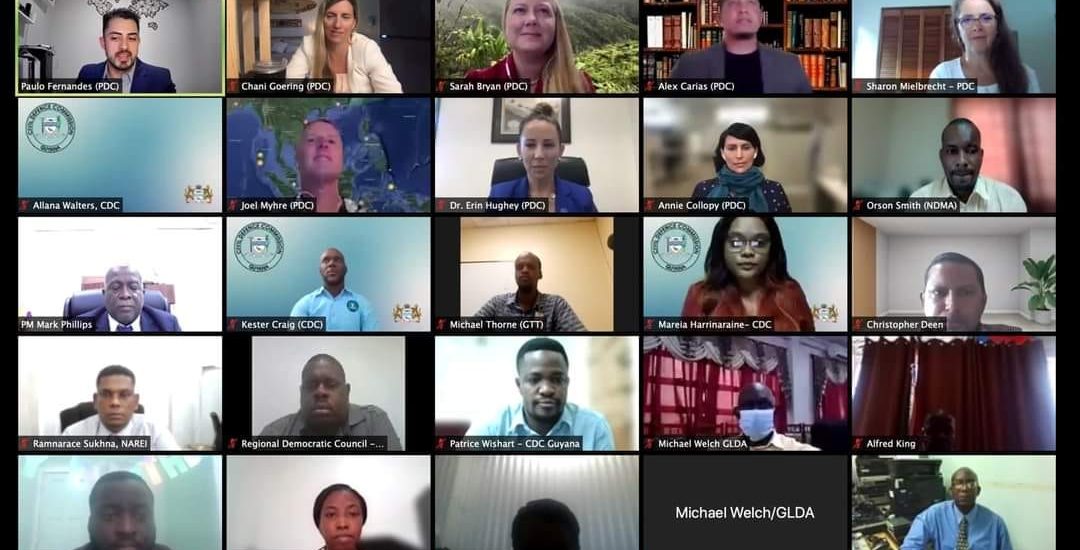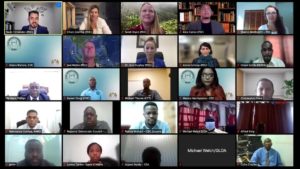- September 9, 2021
- Posted by: Patrice Wishart
- Categories: disaster management, DRR Platform, News, Projects
No Comments

-Prime Minister lauds initiative
The Pacific Disaster Center (PDC) is working with the Civil Defence Commission (CDC) and other stakeholders such as the Private Sector Commission (PSC), Red Cross, the United Nations Development Program (UNDP), the Ministry of Finance (MOF), the Ministry of Agriculture (MOA), Guyana Livestock and Development Authority (GLDA), and the Guyana Energy Agency (GEA) to initiate the National Disaster Preparedness Baseline Assessment (NDPBA). This Assessment began with a virtual workshop yesterday, hosted by PDC, with over 60 participants from various entities and agencies in Guyana.
For more than two decades, Pacific Disaster Center (PDC) has supported the most demanding governments and non-profit organisations worldwide, sharing in the mission to save lives and reduce disaster risk. As an Applied Research Center managed by the University of Hawaii, they are developing new technologies and best practices to help global partners effectively mitigate, prepare for, respond to, and recover from disasters.
Opening remarks were tasked to CDC’s Director General, Lieutenant Colonel Kester Craig, who among other points stressed on the importance of science and technology as crucial components in Disaster Risk Management. He also indicated that this assessment “aims to establish a national baseline for priority hazards and vulnerable communities and populations, with requisite mapping and analysis that aims to strengthen Disaster Risk Management (DRM) across all sectors.” The Director General lamented on being committed to a multi-stakeholder approach for DRM and anticipates that the process will create wide-scale symbiosis. Lt. Col. Craig additionally spoke about the urgency to have such a project bear successful fruit considering the inevitable effects of climate change. He ended his remarks by expressing excitement towards the goals set out in this project.
Dr. Erin Hughey, Director of Global Operations for PDC, intimated in her brief remarks that she is elated to start building a lasting partnership between her entity and that of the CDC and the other participatory stakeholders. She said that the joint program is primarily a true exchange of knowledge and her team is eager to learn about the unique hazard environment of Guyana. Ultimately, according to Dr. Hughey, the aim is to build a safer Guyana and a safer world. The PDC Director is confident that the assessment will be a victory.
The Prime Minister of Guyana, the Honourable Brigadier (Retired) Mark Phillips, then gave his welcoming words. He too lauded the multi-stakeholder approach to such a venture, stating that the participants were crucial components of reducing disaster risk. “Enhancing disaster preparedness for effective response and to “Build Back Better” in recovery, rehabilitation and reconstruction is one of the four priorities outlined in the Sendai Framework for Disaster Risk Reduction, which was adopted by Guyana…” stated Prime Minister Phillips. He indicated that the 2005 flood was a turning point for Guyana’s approach to disaster risk reduction and he trusts that this project will give meaningful insight and guidance towards effective DRM in the near future.
The members of the virtual workshop were then introduced to the NDPBA Project with an overview of how it operates in various facets. The goal framework was showcased, which highlighted the importance of accurate data so that a bridge can be built which would connect the correct resources to meaningful information. Participants also witnessed the layout of DRM software called DISASTERAWARE, and other technological advancements geared at aiding Guyana to prepare for and manage hazards and disasters. A key feature of DISASTERAWARE is an Early Warning System which would disseminate alerts on hazard type, severity and geographical location. As presented by the PDC team, some of the NDPBA benefits will include; encouraging multi-agency cooperation and strengthening disaster management networks, providing necessary tools and data for disaster monitoring, promoting risk-informed decision making and sustainable development, and aligning capacity development efforts with priority needs. Several instances of how the system will work, if employed, were put on display and participants were given opportunities to ask questions and provide feedback. Furthermore, there was a brief demonstration of how the system actually works using real world circumstances such as forest fires.
At the close of the workshop, the Director General of the CDC and Director of Global Operations at PDC expressed their gratitude for the large virtual turnout of stakeholders and their pledged cooperation. Lt. Col. Craig said that most of the features highlighted can be used effectively in Guyana’s quest to manage and prepare for hazard and disaster impacts, while Dr. Hughey indicated how elated she was for the next chapter of the Assessment. Partakers were encouraged to continuously provide feedback via email so that the framework and goals can be amended if necessary. A comprehensive report to be prepared by PDC is expected subsequently.

